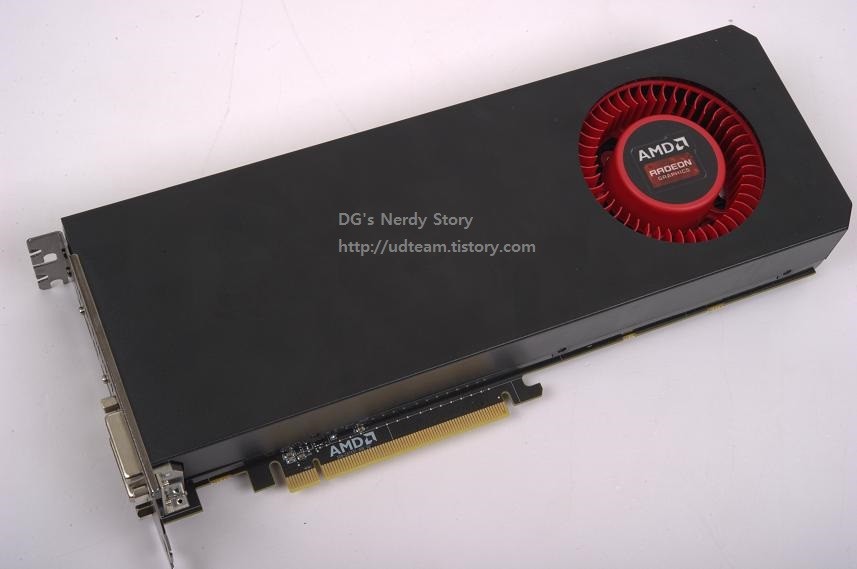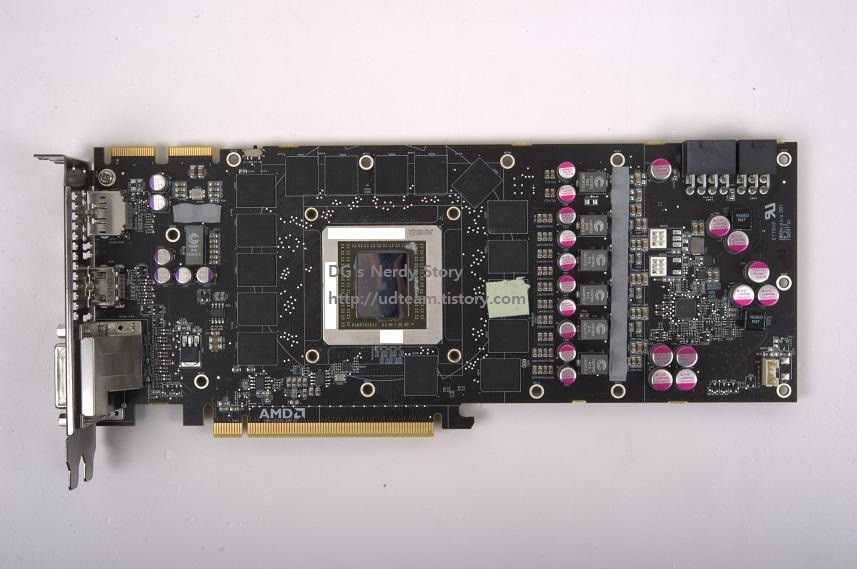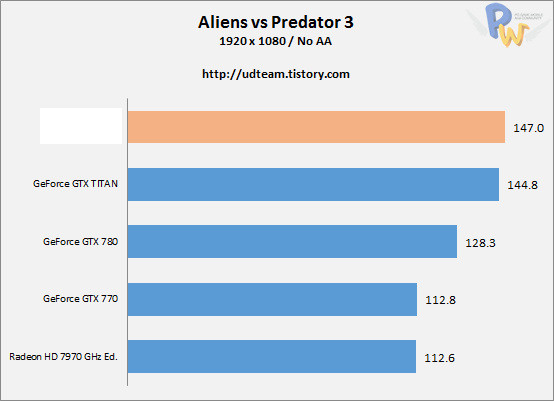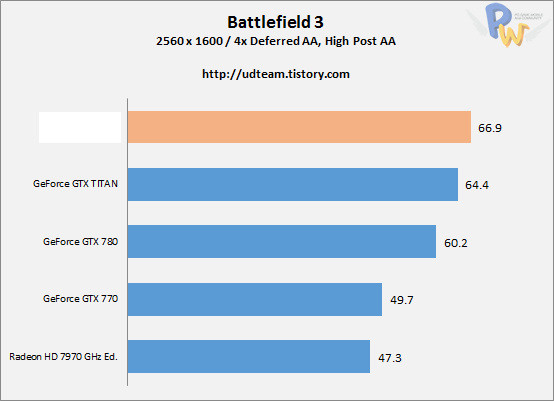Images, Benchmarks, Specifications of AMD's R9-290X
New specifications, as well as images and benchmarks of AMD's upcoming Radeon R9-290X 'Hawaii' graphics card have surfaced.
Earlier this month we reported some specifications of AMD's upcoming Radeon R9-290(X) cards, and now we bring you more. A new report from DG's Nerdy Story, which seems to have been taken offline, shows a number of pictures of the Radeon R9-290X card, as well as some benchmarks.
According to the earlier rumors, as well as newer reports, the card will supposedly feature up to 2816 stream processors, all of which will be split among 44 different clusters. In all likelihood, the Hawaii chips will feature either 32 or 64 ROPs along with about 176 TMUs. The chip will be built on the 28 nm lithography and manufactured by TSMC. It'll feature the GCN 2.0 architecture, as well as support for DirectX 11.2. The GPU is expected to be clocked at 900 MHz or above. The memory interface will be a 512-bit wide memory interface, carrying GDDR5 memory, though no reference capacity was mentioned in the report. The chip appears to carry a total of sixteen memory chips, which is where the idea of a 512-bit memory interface comes from, as 384-bit wide memory interfaces normally come with 12 memory chips.
In benchmarks, the card was earlier rumored to be faster than the GTX Titan, but less powerful than the GTX 690. The benchmarks posted on DG's Nerdy Story support this, and the card appears to be notably more powerful than the Titan. While the model name of the top graphics card is blanked out on the benchmark tables below, we'd say it's fairly safe to assume reference to either the Radeon R9-290X or the Radeon R9-290.
There was no word on what the card would cost, though we can either expect it to be priced in-line or slightly above the GTX Titan. Below it by a fair margin is also a possibility if AMD wants to destroy the competition. That said, there are numerous sources pointing towards a price of just $600. AMD will likely be showcasing the GPUs this week, with sales kicking off around mid-to-end of October, starting with the Radeon R9-290 (Hawaii Pro) and the Radeon R9-290X (Hawaii XT).
Follow us @tomshardware, on Facebook and on Google+.
Get Tom's Hardware's best news and in-depth reviews, straight to your inbox.
Niels Broekhuijsen is a Contributing Writer for Tom's Hardware US. He reviews cases, water cooling and pc builds.
-
jimmysmitty Too bad that AvP is a AMD gaming evolved title and known to perform better on AMD GPUs.Reply
That said it is interesting how these benchmarks show it pulling ahead more with AA enabled than without AA enabled. That's a good sign.
Again we must take these with a grain of salt but the PCB design looks just like a standard Sapphire designed card so it might be real. -
bigshootr8 It'll be interesting to see where things go with the new cards. The Titan card is a interesting card where its part gaming card part production card. So I'd say if this card is a full gaming card that it may be a bit of a unfair comparison and I'd be more interested in the normal retail cards. That fall in line with the 7970 7950 style rather then the $1k cards or the Dual GPU cards.Reply -
beta212 Let the price wars begin!!Reply
But more seriously...We must keep an open mind, IF these benchmarks are true, coupled with a lower price, more ram, more bandwidth, better opencl performance, better overclockability (if the 7xxx is any indication), the Nvidia 780 and the Titian are effectively crippled.
More benchmarks: View this thread in the forums for the pics, the reply system hates picutures.
-
bigshootr8 Reply11590125 said:We must keep an open mind, *IF* these benchmarks are true, coupled with a lower price, more ram, more bandwidth, better opencl performance, better overclockability (if the 7xxx is any indication), the Nvidia 780 and the Titian are effectively crippled.
I remember hearing that when the 680 originally came out that it was org supposed to be the 660Ti. And the 780 is just a lowered down version of the Titan. So I get what you are saying but I have a feeling that AMD/Nvidia both do the holding out game waiting to see what the other person does then one upping them all the time.
THIS is what the CPU wars should be. I mean we can be fan boys over each brand but thsi is what we want form AMD/INTEL. -
CaptainTom In all honesty this card will make Titan/780 owners feel silly supporting what was CLEARLY price gouging by Nvidia. But then again, it should have been obvious from the get go considering an overclocked HD 7970 meets the 780 at half the cost...Reply -
kirilmatthew Statements in a Forbes interview by AMD says that they will not price any single GPU near $1000 and all rumors point towards the 290x at $600 or less, $50 or more cheaper then the 780.Reply -
InvalidError Reply
There is no price war nor will there be any on the CPU side any time soon since very little mainstream software can make use of the processing power already available. Until enough mainstream applications start requiring quad-cores to threaten Intel's market share, I would not expect a major market shift for another 5-10 years.11590150 said:THIS is what the CPU wars should be. I mean we can be fan boys over each brand but thsi is what we want form AMD/INTEL.
Another possibility is that applications and games with embarrassingly parallel computations will simply shove those onto OpenCL and not really care how fast (or slow) the CPU actually is as long as there are sufficient OpenCL resources available. -
bigshootr8 Reply11590253 said:
There is no price war nor will there be any on the CPU side any time soon since very little mainstream software can make use of the processing power already available. Until enough mainstream applications start requiring quad-cores to threaten Intel's market share, I would not expect a major market shift for another 5-10 years.11590150 said:THIS is what the CPU wars should be. I mean we can be fan boys over each brand but thsi is what we want form AMD/INTEL.
Another possibility is that applications and games with embarrassingly parallel computations will simply shove those onto OpenCL and not really care how fast (or slow) the CPU actually is as long as there are sufficient OpenCL resources available.
I'm just saying that the cpu market right now is very stagnant and a lot of that is because intel doesn't really have anyone to push them.
All I was really saying was that with amd and nvidia really pushing each other it would be nice if AMD had the same ability with their CPU line since they are the only other desktop CPU out.
Time will tell with GPU's exciting to see the advancement with things. Although one has to ask themselves outside a game like star citizen what do we really need the extra power for at the current moment. Any high end AMD chip now or Nvidia chip now can pretty much do w.e it wants with the games that are out now with rare exceptions 3d/4k/and multi screens. -
jimmysmitty Reply11590112 said:It'll be interesting to see where things go with the new cards. The Titan card is a interesting card where its part gaming card part production card. So I'd say if this card is a full gaming card that it may be a bit of a unfair comparison and I'd be more interested in the normal retail cards. That fall in line with the 7970 7950 style rather then the $1k cards or the Dual GPU cards.
The difference is that AMD does not cripple their gaming cards from being able to run production apps.
While the FireGLs are designed with production in mind (top of the crop silicon much like server CPUs), a HD7970 eats a Titan up in OpenCL (hence why AMD is so popular with the various Coin mining types which heavily use Open CL) since NVidia makes their gaming GPUs do pretty poor in OpenCL. NVidia wants you to spend a few $K on their Quadros instead.
http://www.tomshardware.com/reviews/geforce-gtx-titan-opencl-cuda-workstation,3474-19.html
I don't see why AMD will change that now unless they get greedy.




